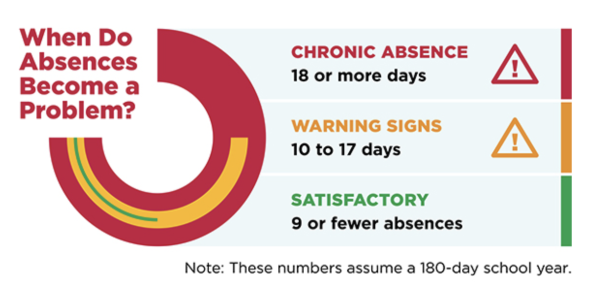Introduction
How many absences is too many?
- Missing a day or two can add up
- When students miss 10% or more of the school year (that's two days a month) - we see an impact on grades and learning
- To stay engaged and on track, your student should miss no more tan 9 days of school a year
Truancy and Chronic Absenteeism
Truancy
Truancy is being out of school 3 times without a valid excuse. Can be any combination of:
- full day absence
- tardies over 30 minutes (T30)
*Three T30s will result in a truancy notification, even if there are no full day absences. The letter will list the tardies, not absences.
We are required by law to notify students' parent/guardian of truancy.
Families have the right to meet with school personnel to discuss solutions to truancy after they are notified that their child has been identified
Chronic Absence
Chronically Absenteeism is when a student misses 10% or more school days at anytime in the school year.
- Excused and Unexcused full day absences count toward chronic absenteeism
- Excused and Unexcused tardies count toward chronic absenteeism
Regular Attendance is Essential!
National and local research has shown that students with frequent absences, whether excused or unexcused, have lower literacy levels, lower grades and higher drop-out rates than students who attend school regularly.
The Governing Board believes that regular attendance plays an important role in student achievement. The Board will work with parents/guardians and students to ensure their compliance with all state attendance laws and may use appropriate legal means to correct problems of chronic absence or truancy. Absence in excess of 10% or more days of school, whether those absences are excused or unexcused, will be considered Chronic Absence. Parents will receive official notification of excessive excused absences. (SFUSD Board Policy 5113)

When Do Absences Become a Problem?
Chronic Absence - 18 or More Days
Warning Signs - 10 to 17 Days
Satisfactory - 9 or Fewer Absences
This page was last updated on October 13, 2023

